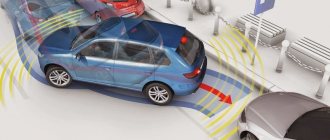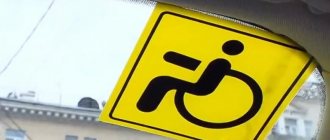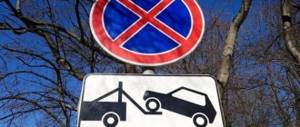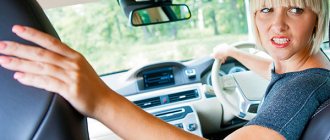Oddly enough, many even experienced drivers feel extremely insecure when it comes to such a common maneuver in a metropolis as parking. However, this can be explained by the fact that until recently drivers were not taught how to park. But even now, despite the inclusion of this element in driving tests, unfortunately, there is no need to talk about good parking skills.
The result of such general driver illiteracy is obvious - you will hardly be able to immediately find a car on the street that does not have damage to its paintwork. There is no doubt that most of them are the result of a collision with fences, poles, curbs or other vehicles after another attempt to park the car in conditions of limited free space.
Meanwhile, there is nothing particularly complicated in this maneuver - parallel parking in fact turns out to be no more difficult than entering/exiting a garage.
Parallel parking: where is it useful?
Parallel parking in reverse is an assistant in urban conditions and an acute shortage of free space.
The ability to park the car correctly allows you to take a seat even in conditions of limited space.
In addition, parallel parking is one of the mandatory exercises when passing your license.
This is not surprising, because the ability to park a car indicates the ingenuity of the person behind the wheel, the ability to feel the technology and the presence of sufficient practical experience.
Some secrets for successful parking
Here are some:
- Parallel parking is much more convenient in reverse. Of course, there are craftsmen who do it the other way around, but even they will not argue with the fact that when parking in reverse, cars are much more maneuverable and easier to control. However, do not forget that in this case the car reacts very sharply to the slightest turns of the steering wheel, so a high level of concentration is required when driving.
- When approaching a parking space, you need to drive up to the car in front close enough to make it convenient to maneuver. Approximately the distance should be half a meter. Naturally, in order to determine this, you will need some driving experience and a feel for the car, but if this is not the case, then it is better to get out and look at the distance from the outside so that there are no unpleasant consequences.
- You shouldn't turn the steering wheel on the spot , although this is very popular among novice car enthusiasts. In fact, this sometimes really helps to simplify driving a vehicle, but the friction force that occurs between the asphalt and a stationary car is too strong, so this control method will ultimately lead to irreversible damage and a call to a service center.
Dimensions
A rather banal thing: you need to learn to feel the dimensions of the car. What does it mean to feel? Grow nerve endings on the bumper? Develop a sixth sense like a bat? Everything is simpler and more prosaic: you need to learn to approximately determine the distance to an obstacle from the picture that you see in the windshield or rear window.
I won’t recommend the “contact parking” method based on the crack of the bumper of a neighboring car as a training method. But getting out of the car and assessing its position as you park is a good habit if you want to develop a sense of size. And in general, constant practice, as in the case of any other driving techniques, in this case is the best thing you can come up with.
A good helper in this case is parking sensors, and they are useful not only at the rear, but also at the front. Indeed, despite its apparent simplicity, determining the gap in front of the hood is just as problematic as behind the trunk - I judge, among other things, by my students, who all the time timidly stand up in their chairs, trying to see something behind the bumper. If the original configuration did not have parking sensors, and you are going to install them, it is better to install them both forward and backward - it will be calmer. And don’t save money, because there is nothing worse than a combination of “buggy” parking sensors and a mediocrely developed eye.
External cameras are also great helpers that will come in handy both from behind and from the front. It's great if you have all-round visibility, but it's now only found on very expensive cars. And even if you have a full set of sensors and cameras, you shouldn’t give up training your eye – you’ll need it!
Step-by-step algorithm of actions
Step-by-step instructions allow you to correctly divide the “Parallel Parking” exercise on a race track into steps, which helps beginners achieve the correct result. It is advisable to adhere to the specified algorithm.
Dimensions of the area for the exercise
There are no requirements for the site where the process is performed. But the parking space should have the following overall dimensions:
- in length it should be the sum of the lengths of two cars, but the exam is taken on a car whose length differs from the average by no more than 30 cm;
- The width of the space is equal to the width of the machine itself plus 1 meter.
Parallel parking technique
If you are learning the basics of driving at a driving school, you can rest assured that this exercise will be included in the program somewhere at the very end, when you already have passable driving skills. But do not expect that you will be able to master this technique properly in one, maximum two times. Therefore, it makes sense to practice this yourself.
Here are step-by-step instructions for parallel parking, as it is taught at the race track (assuming there is both a front and rear car, and sufficient space between them):
- before starting the maneuver, turn on the hazard warning lights;
- then try to approach the front car at a distance of about 50 centimeters so that your front right wheel is located near the left rear corner of the car;
- engage neutral gear, regardless of the type of transmission - this is a mandatory requirement;
- carefully observing what is happening behind you, turning your head, engage reverse gear and slowly start moving;
- quickly turn the steering wheel to the right all the way so that your car moves as steeply as possible towards the right rear corner of the parking area;
- as soon as you see the right headlight of the car standing behind you in the left mirror (your seat will be level with the bumper of the car in front), align the steering wheel to a straight position and continue to slowly back up;
- when your front bumper is level with the bumper of the car in front, turn the steering wheel to the left and drive until the car is parallel to the sidewalk;
- if your car has become a little crooked, or closer to one of the neighbors, correct it;
- after completing the maneuver, put the steering wheel straight; if you have an automatic transmission, turn on the parking mode and do not forget to put the car on the parking brake;
- When you get out of the car, make sure that everything is done correctly, and you will not inconvenience your neighbors in the parking lot.
As you can see, the technique of parallel parking in reverse is not complicated, but mastering it requires three components:
- first study the algorithm in theory and remember its automaticity;
- practice performing techniques on the race track;
- remember how the car behaves when moving in reverse and at the same time actively turning the steering wheel.
When performing a maneuver, the driving school will install marking equipment that cannot be knocked down when passing the exam, which is why it is so important to master the skills of driving using rear-view mirrors when parallel parking in reverse.
Video
Full video tutorial on reverse parking (38 minutes).
Training to enter the box at the traffic police circuit.
Useful 3D lesson - how to park correctly.
Tips for Newbies
A novice driver needs to understand that there is no need to rush on the road. Therefore, if he needs additional practice, he must do it. When following the instructions for parallel parking, it is advisable to pause in time to think about each further action.
For example, wheels must be turned while standing still to avoid confusion and damage to neighboring cars.
It is recommended to practice the exercise yourself by first selecting a free area and drawing the boundaries of the proposed parking area. This way you can improve your skills and prepare for the exam.
Basic tips and rules when parking in reverse
It is very important to follow the regime. This includes the concept of driving carefully. On the roadway, you must be extremely careful when reversing your vehicle. Not a difficult, but responsible maneuver that requires the driver to have fairly high driving skills, concentration and a high sense of responsibility.
As a rule, all practical driving lessons in driving schools begin with the study of this maneuver. Most car enthusiasts remembered how they trained for several hours in a row to drive into the so-called garage.
Good to know! And yet, despite the certain simplicity of reversing, some drivers, after completing the driving course, still experience certain difficulties when moving backwards. We will try to highlight the main tips that may help you avoid unpleasant situations when driving and parking your car in reverse.
Basic Techniques
To avoid penalty points and pass the exam without any problems, it is important to know the step-by-step instructions for parking in reverse:
- Drive to the Start line and stop.
- Turn on first gear and drive to the first “virtual” car (chip “B”). Stop the car as soon as the rear wheel reaches the counter. It is important that the distance between them is minimal. Here, use the capabilities of the legal side mirror.
- Engage reverse gear and turn the steering wheel to the right as far as possible, then start driving.
- Move and control your movement using the left mirror. The car gradually enters the parking space. As soon as the “G” chip is visible in the mirror, you should stop moving.
- Now place the steering wheel straight and start moving slowly until the rear wheel on the left crosses the broken line.
- Turn the steering wheel to the left and start driving again. As a result, the car becomes behind the broken line in the gap between the “virtual” cars.
- Stop, turn off the speed and engage the handbrake. Now turn off the engine.
Features of parallel parking on the autodrome
When performing an exercise at a race track or exam, you will have to navigate not by other cars, but by cones.
- Cross the start line of the exercise, stopping as close to cone 1 as possible.
- Then back up so that the right wheel is aligned with cone 1, guided by the mirrors.
- Stop, turn the steering wheel all the way to the right and start moving backward until cone 2 appears in the mirror.
- Stop and straighten the steering wheel, then continue to back away slowly. In the left mirror you will see how the car crosses the markings with the left rear wheel, after which you need to stop again.
- Turn the steering wheel to the right and check the position of the car relative to the markings.
Applications and programs that can help
The “parallel parking” maneuver in city traffic is not used by all drivers. Having passed the mandatory exam at the traffic police, many people forget how to do it or drive a vehicle that they have not been trained in at a driving school.
For example , driving into a parking lot with a trailer or in a KamAZ will be significantly different from parking in a passenger car.
Therefore, modern cars are equipped with electronic equipment that “knows” how to reverse or how to enter a narrow parking “pocket”. The parking sensors system uses ultrasound to determine the distance to objects and turns on a sound signal if there is a danger of collision. If your car is not equipped with such “smart” technology, it can be installed additionally. The cost of parking sensors depends on the model of your car and the parking system itself and varies from 2,000 to 20,000 rubles .
Common mistakes
The most common driver mistakes are:
- Students press too close to the left edge of the marking in order to minimize the alignment process in the future and get up as correctly as possible from the first twist. This risks the fact that when backing up, you can accidentally knock down the flag or go off the line. During the exam, this, of course, seems like a trifle, but in life such carelessness would lead to damage to your own and other people’s cars, so you will be fined very heavily for it.
- Not turning the steering wheel completely . In order to get up as correctly as possible the first time, it is necessary to turn the steering wheel completely when turning. This will make the alignment process easier, but many people neglect it. Of course, driving schools do not fine you for this specifically, but such inattention can result in a loss of time, which, as you know, is limited during the exam.
- Not completely crossing the sideline. As was said earlier, the car should not stick out from the general row of cars, and if the marked line is not completely crossed, this is exactly what will happen on the road, which means the main movement will be difficult.
What is this
Driving training in the selected driving school always corresponds to the programs developed by the Ministry of Education and Science of the Russian Federation.
The training program for the selected vehicle category includes:
- theoretical part - study of traffic rules, the basics of road safety and basic legislative acts;
- “site” – training and practicing selected practical elements on the site of a driving school’s racing track, most often includes such elements as “overpass”, “snake”, “entering a garage” and “parallel parking”;
- the practical part consists of a certain number of hours spent by a driving school student behind the wheel while driving along city streets using theoretical and practical skills and driving techniques.
The student training program includes elements that will help “new” drivers feel comfortable and confident on the road after successfully passing the traffic police exam and obtaining a driver’s license. Parallel parking is just such a maneuver.
Despite its complexity, this method is the simplest option for those who want to park their car between two already parked cars.
Parallel parking is done in reverse and is most often necessary in urban environments. Having studied the scheme and principle of this maneuver, you will be able to place your “swallow” in any place you like.
Why are points reduced in the traffic police exam?
Today, the driving test includes several important exercises. One of them is called “Parking a vehicle and leaving a parking space.” This discipline tests skills that allow you to enter and exit a parking lot within a certain period of time without touching the marking equipment.
At racing tracks, special markings are installed, with the help of which assessment is carried out. All its cones and lines imitate the following real landmarks:
Name of the conePoint on the car bodyCar
| B | Left rear corner | standing in front |
| C | Left front corner | Rear |
| D | Right front corner | Rear |
This marking simulates a real situation, and therefore allows you to successfully perform such parking in the future.
When performing this exercise, errors are taken into account and the following penalty points are awarded:
- failure to complete the exercise within 2 minutes – 3 points;
- damage to fences, collision with solid lines – 3 points;
- the car did not cross the “CB” line - 3 points;
- engine stalled – 1 point.
If the examinee scores 3 penalty points, he fails.
How to park in front
The forward entry method is tested so that in the city the driver can park with a limited amount of free space, for example, between two other vehicles.
Entry from the front
Execution order:
- The front bumper of the car should practically rest against a nearby obstacle, in this case another car.
- Be careful and back up a little.
- Once the right front corner is in line with the parking axis, you can start moving forward.
- In order to get out of the car without damaging your own and neighboring vehicles, you need to take the correct width, approximately a quarter of the width of a standard car.
What you need to pay attention to in order to park in the city without problems using this method:
- The car must be parked parallel to the curb (to ensure that it is positioned correctly, you need to use the rear side windows);
- It is necessary to park strictly in the center, that is, the distance between the parked car and the two standing on its sides must be the same.











